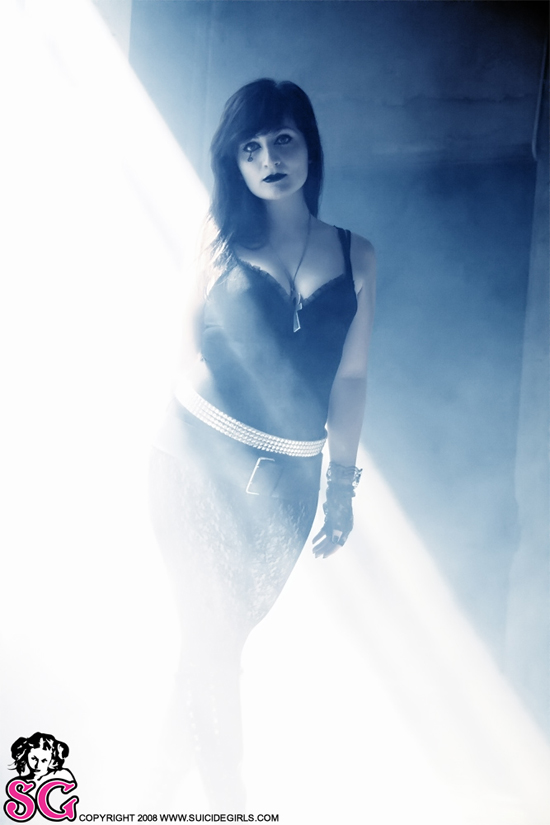
by Brett Warner
There’s dust moving through the light, I notice three drinks in. It’s Factory Monday at The Necto nightclub in Ann Arbor, Michigan and I’m surrounded by a significant representation of the local gothic community. They’re projecting some anime film against the wall, which doesn’t strike me as being very goth, but that’s been the common theme of the evening: a vodka-fueled internal struggle with the definition of “gothness” and how to embody it. DJ Jinx is shaking the walls with a Combichrist song I’ve learned to recognize, which causes the textured light (equal parts smoke machine mist and various makeup powders) to twitch and sway to the relentless beat. I’ve been to a handful of Factory Mondays, and each time I can’t help but feel like Colin Farrell at the beginning of the Miami Vice movie—i.e. a total narc. Apart from my Elvis Costello glasses, penchant for black hoodies and old Depeche Mode records, there’s little to no social thread connecting me to this scene. But that’s the secret to understanding the gothic community on southeast Michigan: 1.) They don’t care about me, and 2.) Most of them only very casually care about goth stuff.
The original Goths had little time for vodka-cranberries or Tim Burton films, they were busy conquering the Western Roman Empire throughout the third and fourth centuries. The terms “goth” and “gothic” were largely deprecatory up through the late Renaissance, when medieval architecture was renamed “Gothic” in sharp contrast with then-popular classical styles. An eventual appreciation of medieval romanticism lead to the creation of Gothic literature, beginning with Horace Walpole’s novel The Castle of Otranto in 1764. With Keats, Poe, and Baudelaire establishing the movement’s bleak, dark and romantic tone, Gothic literature informed German expressionist and early horror genre films, the key influence (along with late ‘70s English post-punk music and BDSM subculture) of the modern goth community. While blatantly commercialized in the United States and England (entrepreneur Orv Madden opened the first Hot Topic chain store in 1988), the movement continues to thrive in Germany and other European countries from which the original tribes sprung.

Ann Arbor’s contribution to goth subculture is a multi-level nightclub originally known as The Nectarine Ballroom that also puts on gay, college, and Top 40 theme nights each week. A friendlier, more social alternative to Detroit’s notoriously sleazy City Club, Monday nights at Necto feature the same social dichotomies as any other club, college party, or large gathering of drunk semi-adults. For every two or three septum-pierced, red-haired, hardcore O.G’s, you’re sure to find one drunk frat dude drinking Bud Light, smoking a pack of Winston Lights and talking much louder than necessary. Whether these American Eagle patrons are attempting to infiltrate the industrial club crowd or simply wandered in on the wrong night is anyone’s guess, but they seem very at home regardless. There are also the obvious newbies, broken down into two subcategories: those who’ve clearly tried to appear fashionably normative, and those who can’t and won’t make the effort (including yours truly).
The narrow-minded, condescending conclusion would be to declare, “Members of the goth community are real people with actual jobs and hobbies and interests that don’t include wearing black and feeling sad all the time!” as if it were some un-foregone revelation. If I’ve learned anything from my limited goth club experience in southeast Michigan though, it’s that the very term “goth” signifies very little… or, at least, not what you’d think.
“Not everybody at the club has embraced the whole Lady Gaga thing,” says Necto regular Jay Itchon, who’s been a staple at Factory Mondays since their earliest incarnation. “I thought it was funny but annoying, though now I get it. I even listen to Gaga outside of the club on a regular basis.” I’ve asked Jay to comment on the inclusion of “Bad Romance” in a DJ set of mostly standard, industrial tinged dance tunes and bleak ‘80s classics. It’s easy to balk such an established, mainstream song popping up in a purportedly counter-cultural social environment, but no one seems too bothered. If anything, the dance floor sees more action during Ke$ha’s “Tik Tok” than Columbine’s latest single. You could argue that it’s a prime example of social reclamation, an ironic embrace of mainstream, normative iconography…but I think people just really like that song.
At some point in the evening, between ordering a pint of Guinness and discussing Stephen King’s On Writing with my Necto veteran girlfriend, it strikes me that I should write about my outside-looking-in experiences at Factory Monday, that somehow my plain demeanor and uninitiated persona might have something new or interesting to say about a social group that has no problem speaking for itself. Of course now, twenty-four sober hours and 851 words later, I’ve wound up with exactly the misinformed, misdirected, and abysmally contrived sort of essay I’d planned on avoiding. In focusing on the dreaded “g” word (which I’ve managed to use a horrific 21 times in this piece), I’ve completely missed the bluntly obvious lesson: Factory Monday at Necto is just that… Monday. We drink, dance to bad music, and stumble through the parking structure afterwards. As Chuck Klosterman once wrote, “When the tapestry of alienation becomes the status quo, disaffection merely becomes fashion.”
Anime, vodka, and The Eurythmics… one of these Monday nights, it will all start to make sense.

